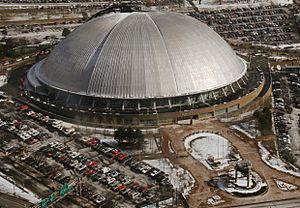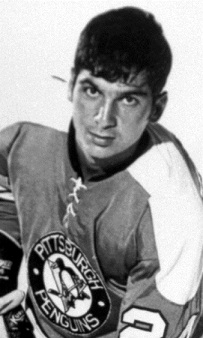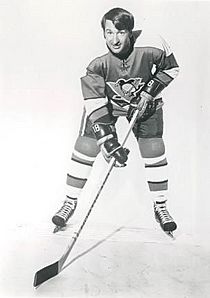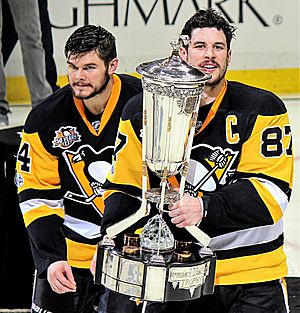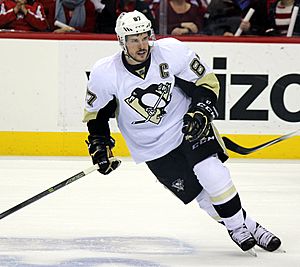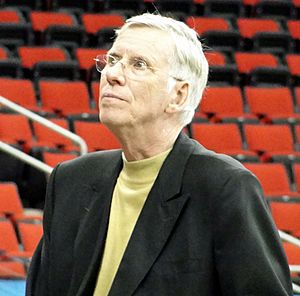Pittsburgh Penguins facts for kids
Quick facts for kids Pittsburgh Penguins |
|
|---|---|
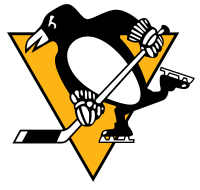 |
|
| Conference | Eastern |
| Division | Metropolitan |
| Founded | 1967 |
| History | Pittsburgh Penguins 1967–present |
| Home arena | PPG Paints Arena |
| City | Pittsburgh, Pennsylvania |
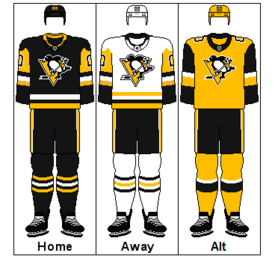 |
|
| Colors | Black, Pittsburgh gold, white |
| Media | SportsNet Pittsburgh The X (105.9 FM) ESPN Pittsburgh (970 AM) Pittsburgh Penguins Radio Network |
| Owner(s) | Fenway Sports Group< Mario Lemieux (minority) |
| General manager | Kyle Dubas |
| Head coach | Dan Muse |
| Captain | Sidney Crosby |
| Minor league affiliates | Wilkes-Barre/Scranton Penguins (AHL) Wheeling Nailers (ECHL) |
| Stanley Cups | 5 (1990–91, 1991–92, 2008–09, 2015–16, 2016–17) |
| Conference championships | 6 (1990–91, 1991–92, 2007–08, 2008–09, 2015–16, 2016–17) |
| Presidents' Trophies | 1 (1992–93) |
| Division championships | 9 (1990–91, 1992–93, 1993–94, 1995–96, 1997–98, 2007–08, 2012–13, 2013–14, 2020–21) |
The Pittsburgh Penguins (often called the Pens) are a professional ice hockey team from Pittsburgh. They play in the National Hockey League (NHL) as part of the Metropolitan Division in the Eastern Conference. The team has played its home games at PPG Paints Arena since 2010. Before that, they played at the Civic Arena, also known as "the Igloo". The Penguins also have two minor league teams: the Wilkes-Barre/Scranton Penguins (AHL) and the Wheeling Nailers (ECHL).
The Penguins started in 1967 as an expansion team. They have reached the Stanley Cup Final six times and won the Stanley Cup five times. Their wins were in 1991, 1992, 2009, 2016, and 2017. They are tied with the Edmonton Oilers for the most Stanley Cup wins among teams not part of the "Original Six". Winning in 2016 and 2017 made them the first team to win back-to-back Stanley Cups in the salary cap era. Many former Penguins players are in the Hockey Hall of Fame. This includes co-owner Mario Lemieux, who bought the team in 1999 and saved it from financial trouble.
Contents
Team History
Starting Out (1967–1984)
Before the Penguins, Pittsburgh had other hockey teams. The NHL's Pittsburgh Pirates played from 1925 to 1930. The American Hockey League's Pittsburgh Hornets played from 1936 to 1967. In 1965, Jack McGregor, a state senator, worked to bring an NHL team back to Pittsburgh. He formed a group of investors, including H. J. Heinz Company heir H. J. Heinz III and Pittsburgh Steelers' owner Art Rooney.
To get an expansion team, McGregor asked Rooney to help get votes from other NHL owners. Their efforts worked, and on February 8, 1966, Pittsburgh was chosen for the 1967–68 season. The Penguins paid $2.5 million to join the league. The Civic Arena was made bigger to hold 12,500 fans, meeting NHL rules.
A contest was held to name the team. Out of 26,000 entries, 700 picked "Penguins". This name was inspired because the team would play in the "Igloo," the nickname for the Civic Arena. The first logo showed a penguin in front of a triangle, which stood for Pittsburgh's "Golden Triangle" downtown.
The Penguins' first general manager, Jack Riley, started the team's first training camp in September 1967. The team played its first exhibition game against the Philadelphia Flyers. Because of strict rules, most top players stayed with the "Original Six" teams. The first Penguins team had older players like Andy Bathgate and Leo Boivin, and some former minor league players. George Sullivan was the first head coach, and Ab McDonald was the first captain.
On October 11, 1967, the Penguins played their first home game against the Montreal Canadiens. On October 21, 1967, they became the first expansion team to beat an Original Six team, winning 4–2 against the Chicago Black Hawks. However, the team finished fifth in their division and missed the playoffs. Goaltender Les Binkley was a standout player.
The next season, the team struggled even more. Changes were made, and new players like Jean Pronovost joined.
Playoff Success and a Sad Loss (1969–1974)
In the 1969 draft, the Penguins picked Michel Briere. He quickly became a star, compared to famous players like Phil Esposito. Briere helped Pittsburgh reach the playoffs for the first time since the 1928 Pirates. The Penguins swept the Oakland Seals in the quarterfinals. Briere scored the winning goal in overtime. In the semifinals, they lost to the St. Louis Blues. Briere led the team in playoff scoring.
Sadly, just days after the playoffs, Briere was in a car crash in May 1970. He suffered a brain injury and fell into a coma, passing away a year later. His number 21 jersey was never used again and was officially retired in 2001.
In the 1970–71 season, the Penguins missed the playoffs. They made the playoffs again in 1972 but were swept by the Chicago Black Hawks. The team had some good players like Pronovost and Syl Apps Jr., but not enough depth.
In 1974, general manager Jack Riley was replaced by Jack Button. Button made trades to improve the team, and they got better, but still missed the playoffs. In early 1975, the Penguins faced serious financial problems and almost had to close or move. A group led by Wren Blair stepped in to save the team, and it was eventually bought by Edward J. DeBartolo, Sr..
New Colors and Playoff Runs (1974–1982)
In the mid-1970s, Pittsburgh had strong offensive players, including the "Century Line" of Syl Apps, Lowell MacDonald, and Jean Pronovost. They almost reached the semifinals in 1975 but lost to the New York Islanders after leading 3–0 in the series. The team's defense was not strong enough for consistent playoff success.
The Penguins missed the playoffs in 1977–78. The general manager, Baz Bastien, made some trades that hurt the team in the long run. The decade ended with a playoff appearance in 1979, where they beat the Buffalo Sabres but then lost to the Boston Bruins.
In January 1980, the Penguins changed their team colors from blue and white to black and gold. This was done to match Pittsburgh's other sports teams, the Pittsburgh Pirates and the Pittsburgh Steelers, and the City of Pittsburgh flag. The Bruins protested, saying they owned black and gold colors. But the Penguins showed that the old NHL Pittsburgh Pirates also used black and gold. The NHL agreed, and the Penguins officially wore black and gold uniforms on January 30, 1980.
The Penguins struggled in the early 1980s. However, they often played tough against stronger teams in the playoffs. In 1980, they pushed the Bruins to the limit. In 1981, they lost a close overtime game to the St. Louis Blues. In the 1982 playoffs, they had a 3–1 lead against the reigning champion New York Islanders but lost the series in overtime. This was their last playoff appearance until 1989.
The Lemieux–Jagr Era (1984–2005)
The team had the worst record in the league in both the 1982–83 and 1983–84 seasons. The Penguins were in financial trouble and might have moved or folded. But Mario Lemieux, a highly anticipated draft pick, was available in the 1984 NHL entry draft. The Penguins made moves that seemed to weaken the team on purpose to ensure they finished last and could draft Lemieux. They succeeded, drafting Lemieux first overall.
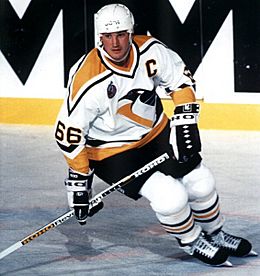
Lemieux made an immediate impact, scoring on his very first shot in his first NHL game. However, the team still missed the playoffs for four more years. In the late 1980s, the Penguins added strong players like defenseman Paul Coffey and young talents Kevin Stevens and Rob Brown. They also got a top goaltender, Tom Barrasso. These additions helped Lemieux, but the team still struggled to make the playoffs. They missed by one or two games for several seasons.
In 1989, Pittsburgh finally made the playoffs, with Lemieux leading the league in scoring. On December 31, 1988, Lemieux made history by scoring a goal in all five possible game situations in one game. The Penguins swept the New York Rangers in the first round but lost to the Philadelphia Flyers in the second round. Lemieux scored five goals in one game during that series.
Winning Back-to-Back Stanley Cups (1989–1997)
A back injury shortened Lemieux's 1989–90 season, and the Penguins missed the playoffs. In 1990, the team added key players like Joe Mullen, Larry Murphy, and Ron Francis. They also drafted Jaromir Jagr with the fifth pick. Jagr became another superstar for the team.
These changes led to the Penguins winning their first Stanley Cup in 1991. They beat the Minnesota North Stars in six games, with an 8–0 victory in the final game. After their win, the Penguins visited President George H. W. Bush at the White House, the first NHL team to do so. The next season, coach Bob Johnson passed away from cancer. Scotty Bowman took over as coach, and the team swept the Chicago Blackhawks to win their second straight Stanley Cup in 1991–92.
In 1993, Lemieux was diagnosed with Hodgkin lymphoma. Despite this, he returned to play and won his fourth Art Ross Trophy as the scoring champion. Pittsburgh had its best regular season ever, winning the Presidents' Trophy with a record of 56–21–7. The team even won an NHL-record 17 games in a row. However, in the 1993 playoffs, the New York Islanders eliminated them in seven games.
The Penguins remained a strong team throughout the 1990s. Players like Alexei Kovalev and Martin Straka joined the team. Even with many changes, the Penguins reached the playoffs every year. They lost in the first round in 1994, the second round in 1995, and the conference finals in 1996. The 1997 playoffs saw them lose in the first round to the Philadelphia Flyers.
Lemieux's Retirement and Return (1997–2001)
On April 6, 1997, Mario Lemieux announced his retirement due to health issues. He was so respected that he was inducted into the Hockey Hall of Fame the same year, without the usual three-year wait. His retirement marked the start of a difficult period for the team.
The team was eliminated in the first round of the playoffs in 1998 and the second round in 1999. In 2000, they surprised the Washington Capitals but then lost to the Philadelphia Flyers.
By this time, the Penguins were in serious financial trouble. They owed a lot of money and had to file for bankruptcy in November 1998. Lemieux stepped in with a unique plan. The team owed him $32.5 million in deferred salary. He offered to turn this debt into ownership, giving him control of the team. He also promised to keep the team in Pittsburgh. The NHL and the courts agreed, and Lemieux became the owner on September 3, 1999, saving the team for a second time.
Lemieux surprised everyone again on December 8, 2000, announcing he would return to play for the Penguins. On December 27, 2000, he played his first game in 44 months, becoming the first player-owner in NHL history. Lemieux helped lead the Penguins deep into the 2001 playoffs. They won an exciting Game 7 against the Buffalo Sabres in overtime. They then lost to the New Jersey Devils in the conference finals.
Rebuilding the Team (2001–2005)
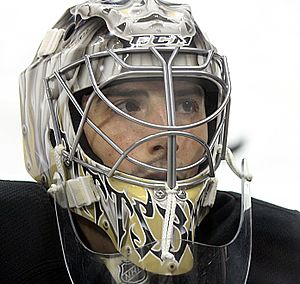
The Penguins' attendance had dropped in the late 1990s. To save money, they traded superstar Jaromir Jagr in 2001. The Penguins missed the playoffs in 2002 for the first time in 12 years. In the 2003 NHL entry draft, the Penguins picked goaltender Marc-Andre Fleury first overall.
The 2003–04 season was tough. Lemieux missed most games due to a hip injury, and attendance was the lowest in the NHL. The team hired former player Eddie Olczyk as head coach. They finished with the worst record in the NHL, winning only 23 games. This meant they had a high draft pick. They missed out on the first pick in the 2004 NHL entry draft (which was Alexander Ovechkin), but they drafted Evgeni Malkin second overall. However, a dispute kept Malkin from joining the team right away.
By this time, the Penguins were in financial trouble again. Their home arena, the Civic Arena, was the oldest in the NHL. Lemieux tried to get a new arena built but couldn't. He started looking into selling or moving the team to Kansas City, Missouri. The 2004–05 NHL season was canceled due to disagreements over financial issues for teams like the Penguins. During the lockout, Penguins players played in minor leagues or in Europe.
The Crosby–Malkin Era (2005–Present)
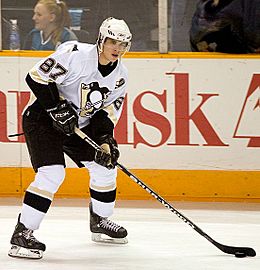
When the lockout ended in 2005, the NHL held a special draft lottery. The Penguins won the first overall pick. Everyone knew Quebec Major Junior Hockey League (QMJHL) star Sidney Crosby would be the top pick. The Penguins drafted Crosby on July 30, 2005, which brought huge excitement back to Pittsburgh hockey.
The team started rebuilding under the new salary cap rules. Evgeni Malkin, drafted in 2004, could not join immediately due to a contract issue in Russia. Crosby's arrival instantly boosted attendance. However, wins didn't come right away. The team had a long losing streak, leading to a coaching change from Olczyk to Michel Therrien. On January 24, 2006, Lemieux announced his second and final retirement due to an irregular heartbeat. He finished as one of the NHL's all-time top scorers.
Despite the team's struggles, Crosby became a league star, scoring 102 points in his first season. He finished second for the Calder Memorial Trophy (Rookie of the Year). The Penguins had the worst record in the Eastern Conference again. They received the second overall pick in the 2006 NHL entry draft and selected Jordan Staal. On May 25, Ray Shero became the new general manager.
Return to Glory and Third Stanley Cup (2006–2010)
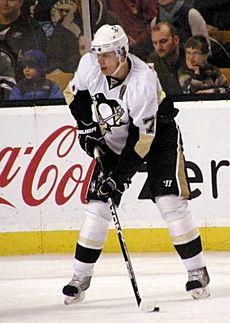
On October 18, 2006, Evgeni Malkin finally made his NHL debut. He set a modern NHL record by scoring a goal in each of his first six games. Malkin also had points in 16 games in a row. The Penguins finished the 2006–07 season in fifth place in the Eastern Conference with 105 points. This was a huge improvement from the previous season. In the 2007 playoffs, the Ottawa Senators defeated them. At the end of the season, Malkin won the Calder Memorial Trophy as Rookie of the Year.
On March 13, 2007, an agreement was announced to build a new arena, the Consol Energy Center. This guaranteed the Penguins would stay in Pittsburgh. The team signed a 30-year lease on September 19, 2007.
After a slow start to the 2007–08 season, Crosby and goaltender Marc-Andre Fleury were injured. But Malkin stepped up and led the team. On April 2, 2008, the Penguins won the Atlantic Division title, their first in 10 years. Malkin finished second in the league with 106 points. The team had a great playoff run, beating Ottawa, the New York Rangers, and the Philadelphia Flyers to win the Prince of Wales Trophy. Pittsburgh lost the 2008 Stanley Cup Final to the Detroit Red Wings in six games. Crosby tied for the playoff scoring lead.
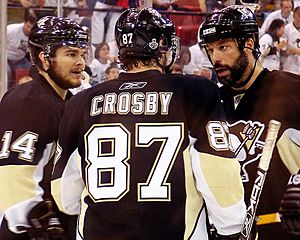
In the 2008–09 season, Malkin won the Art Ross Trophy for leading the league in points. Crosby finished third in scoring. The team's performance improved after Dan Bylsma replaced head coach Therrien. The Penguins secured home-ice advantage and defeated the Philadelphia Flyers in six games. They then won a tough seven-game series against Washington. In the conference finals, they swept the Carolina Hurricanes. This sent them to their second straight Stanley Cup Final against the Detroit Red Wings. After losing the first two games, the Penguins won games 3 and 4 at home. In Game 7 in Detroit, Maxime Talbot scored two goals, and the Penguins won 2–1, earning their third Stanley Cup. Malkin was named the playoff MVP.
During the 2009–10 season, Crosby scored 109 points and won the Maurice "Rocket Richard Trophy as the top goal scorer. The Penguins, seeded fourth, beat the Ottawa Senators in six games. In the next round, they faced the Montreal Canadiens. The series went to a decisive Game 7, which the Penguins lost 5–2. This was their last game at Mellon Arena.
New Arena and Injuries (2010–2015)

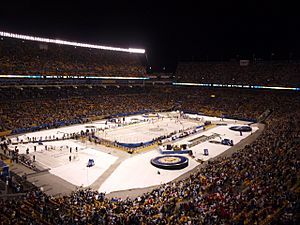
In 2010–11, the Penguins played their first game in Consol Energy Center. The season was affected by injuries to Crosby (concussion) and Malkin (knee). The team lost in the playoffs to the Tampa Bay Lightning, blowing a 3–1 series lead. With Crosby still out at the start of the 2011–12 season, Malkin led the team, finishing with 50 goals and 109 points. The Penguins won 51 games. Despite high hopes for the 2012 playoffs, their rivals, the Philadelphia Flyers, defeated them in six games. Malkin won the Hart Memorial Trophy and the Lester B. Pearson award. After this loss, general manager Ray Shero made changes to the team.
During the lockout-shortened 2012–13 season, the Penguins again dealt with injuries. They finished first in the Eastern Conference. They beat the New York Islanders in six games and the Ottawa Senators in five games. However, they were swept by the Boston Bruins in the conference finals, scoring only two goals in four games. On June 13, 2013, Malkin signed an eight-year contract extension.
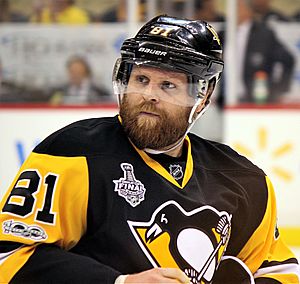
In the 2013–14 season, the Penguins had many injuries. Still, they won the Metropolitan Division. In the playoffs, they beat the Columbus Blue Jackets but then lost to the New York Rangers in seven games, despite leading the series 3–1. This led to general manager Shero being fired. Jim Rutherford became the new general manager on June 6. Rutherford then fired head coach Dan Bylsma and hired Mike Johnston. In the 2014–15 season, the Penguins led their division early on but fell to fourth due to injuries and illnesses. They lost to the New York Rangers in the first round of the playoffs. In the off-season, Rutherford traded for star winger Phil Kessel.
Back-to-Back Stanley Cups and 50th Anniversary (2015–2017)
With Kessel, expectations were high for the 2015–16 season. But by December 2015, the team was barely winning. Head coach Mike Johnston was fired and replaced by Mike Sullivan. General manager Jim Rutherford then made more trades.
The Penguins made the playoffs for the tenth season in a row, finishing second in their division. In the playoffs, they defeated the Rangers, Capitals, and Lightning to win the Eastern Conference championship. They then faced the San Jose Sharks in the Stanley Cup Final. On June 12, 2016, the Penguins beat the Sharks in six games to win their fourth Stanley Cup. Captain Sidney Crosby was awarded the Conn Smythe Trophy as playoff MVP.
The Penguins started their 50th anniversary season as defending Stanley Cup champions. They raised their championship banner on October 13, 2016. In the 2017 playoffs, they beat the Columbus Blue Jackets in five games. In the second round, they faced their rival Washington Capitals for the second year in a row, winning a seven-game series. In the conference finals, the Penguins eliminated the Ottawa Senators in seven games to reach the Stanley Cup Final against the Nashville Predators. The Penguins won the first two games, lost the next two, then dominated games five and six to win the Stanley Cup for the second straight year. By defending their title, the Penguins became the first team since the 1997–98 Detroit Red Wings to win back-to-back championships, and the first to do so in the salary cap era.
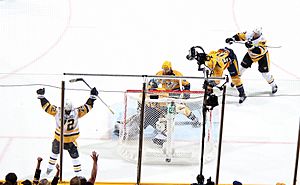
Playoff Streak and Recent Seasons (2017–Present)
Before the 2017–18 season, the Penguins lost longtime goaltender Marc-Andre Fleury in the 2017 NHL expansion draft. Still, the Penguins made the playoffs again, finishing with 100 points. They beat the Philadelphia Flyers in the first round but lost to the eventual Stanley Cup champion Washington Capitals. In the next season, they made the playoffs but were swept by the New York Islanders. In the 2020 playoffs, shortened by the COVID-19 pandemic, they lost to the Montreal Canadiens in the qualifying round.
On February 9, 2021, Ron Hextall became the new general manager, and Brian Burke was hired as president of hockey operations. On February 21, Crosby played his 1,000th NHL game for the team. The Penguins won the East Division title, extending their playoff streak to 15 seasons. This became the longest active streak in North American sports. The 2020–21 season ended in Game 6 of the first round of the 2021 playoffs against the New York Islanders.
On November 29, 2021, Fenway Sports Group announced they would buy a controlling share of the Penguins. They officially became the majority owners on December 31, 2021. In the first round of the 2022 playoffs, the Penguins lost to the New York Rangers in seven games, despite leading the series 3–1. This was the first time the Penguins lost a Game 7 on the road.
The 2022–23 season saw two milestones. On November 23, 2022, Evgeni Malkin played his 1,000th NHL game. Kris Letang also played his 1,000th game on April 2, 2023. However, the Penguins missed the playoffs for the first time since Crosby's rookie season in 2005–06, ending a 16-season playoff streak. This led to Burke and Hextall being dismissed.
On June 1, 2023, Kyle Dubas was named the team's new president of hockey operations. On August 6, the Penguins traded for defenseman Erik Karlsson. On February 18, 2024, the Penguins retired Jaromir Jagr's No. 68 jersey. Before the NHL trade deadline, the Penguins traded Jake Guentzel. Despite a late push, the Penguins missed the playoffs for the second year in a row.
On September 16, 2024, Sidney Crosby signed a two-year contract extension. The 2024–25 season saw many milestones for Crosby and Malkin. On October 10, Malkin recorded his 800th career assist. Two days later, he reached 1,300 NHL points. On October 16, Malkin scored his 500th career goal. On November 23, Crosby scored his 600th NHL goal. On April 6, 2025, the Penguins were eliminated from playoff contention for the third straight season. This was their first losing season since 2005–06. On April 28, head coach Sullivan and the Penguins agreed to end his 10-season time with the team. Dan Muse was hired as head coach on June 4, 2025.
Team Information
Team Colors and Logos
When the Penguins started in 1967, their colors were dark blue, light blue, and white. Their uniforms had "Pittsburgh" written diagonally across the front. The logo showed a penguin playing hockey in front of an upside-down triangle, symbolizing Pittsburgh's "Golden Triangle." A new version of the logo came out in the second season, making the penguin look sleeker.
The team's original colors were powder blue, navy blue, and white. The powder blue changed to royal blue in 1973 but returned in 1977. In 1980, the team switched to black and gold. This was to match Pittsburgh's other sports teams, the Pirates and Steelers, and the city's official colors. The Boston Bruins protested, saying they owned black and gold. But the Penguins pointed out that the old NHL Pittsburgh Pirates also used black and gold. The NHL agreed, and Pittsburgh could use black and gold.
The Penguins mostly wore the black and gold "skating penguin" uniform from 1980 to 1992. In the 1992–93 season, new uniforms were introduced with a "flying penguin" logo, also called "Robopenguin." The away uniforms brought back the diagonal "Pittsburgh" script. In 1995, the team added a second alternate jersey with different stripe designs. This jersey became so popular that it became their away jersey in 1997.
In 2000, the "skating penguin" logo returned, but with a "Vegas gold" shade. After 2002, the "skating penguin" became the main logo again. When new jerseys came out for the 2007–08 season, the "flying penguin" logo was removed from the shoulders.
Since the 2003–04 NHL season, the Penguins have worn their black jerseys at home. They wore their powder blue "throwback" jerseys in the 2008 Winter Classic. A new dark blue third jersey debuted at the 2011 Winter Classic. This jersey was sometimes called the "Blue Jerseys of Doom" because Sidney Crosby and Evgeni Malkin got injured while wearing them.
In 2014, the Penguins released new alternate uniforms. These black uniforms were throwbacks to the early days of Mario Lemieux's career, like the ones worn when they won the Stanley Cups in 1991 and 1992. These new uniforms brought back "Pittsburgh gold," a specific shade of gold. The Penguins later brought back a white version of these "Pittsburgh gold" uniforms. A special patch was added to the uniforms during the 2016–17 season to celebrate the team's 50th anniversary.
For the 2017 Stadium Series against the Philadelphia Flyers, the Penguins wore a special gold uniform. This design became the basis for the team's third uniform in the 2018–19 season. In 2019, the Penguins wore all-black uniforms against the Flyers in the 2019 Stadium Series.
In 2021, the Penguins wore white "Reverse Retro" uniforms based on their 1992–97 look. In the 2022–23 season, they unveiled a second "Reverse Retro" uniform, a black version of the "flying penguin" uniform from 1992 to 2002. For the 2023 Winter Classic, the Penguins wore a vintage white uniform with a gold "P" logo, honoring the old NHL Pirates.
Home Arenas
The Penguins played at the Civic Arena for over 45 seasons, starting in 1967. In September 2010, they moved to Consol Energy Center (now called PPG Paints Arena). The Penguins also played two "home" games in Richfield, Ohio, in 1992 and 1993.

From 1995 to 2015, the IceoPlex at Southpointe was the team's practice facility. In August 2015, the Penguins and the University of Pittsburgh Medical Center (UPMC) opened the UPMC Lemieux Sports Complex. This new facility in Cranberry Township combines a practice rink for the team with a sports medicine center. It replaced their old practice facilities.
Like most NHL arenas, the Penguins use a goal horn when they score a goal at home. It also plays before home games and after a Penguins victory. Their current goal horn was introduced in 2005 when Sidney Crosby joined the team.
Minor League Teams
The Penguins have two minor league teams. The Wilkes-Barre/Scranton Penguins are their AHL team and have played in Wilkes-Barre Township, Pennsylvania, since 1999. Their ECHL team is the Wheeling Nailers, which they have been associated with since 2000.
Fan Support
Early in their history, the Penguins struggled to get fan support. Sometimes, only about 6,000 fans would attend games in an arena that held over 16,000. Fan support was so low that the NHL was fine with the team moving.
When Mario Lemieux was drafted, interest in hockey grew. His amazing play steadily increased the fanbase. The arrival of Sidney Crosby further boosted fan interest after the team had struggled.
Today, the Penguins are one of the NHL's most popular teams, especially among American teams not part of the "Original Six." They are considered the second most popular professional sports team in Pittsburgh, after the Steelers. A 2007 survey ranked the Penguins 20th overall among 122 major sports teams and third among NHL teams. The Penguins' popularity has sometimes even rivaled that of the Steelers locally.
Community Involvement
The Pittsburgh Penguins Foundation does many community activities. They support youth and families through hockey education and charity work.
Season Records
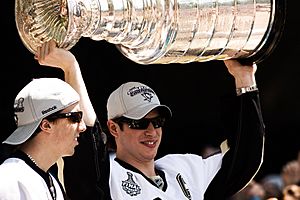
Here are the results for the last five seasons for the Penguins.
Note: GP = Games played, W = Wins, L = Losses, OTL = Overtime Losses, Pts = Points, GF = Goals for, GA = Goals against
| Season | GP | W | L | OTL | Pts | GF | GA | Finish | Playoffs |
| 2020–21 | 56 | 37 | 16 | 3 | 77 | 196 | 156 | 1st, East | Lost in first round, 2–4 (Islanders) |
| 2021–22 | 82 | 46 | 25 | 11 | 103 | 272 | 229 | 3rd, Metropolitan | Lost in first round, 3–4 (Rangers) |
| 2022–23 | 82 | 40 | 31 | 11 | 91 | 262 | 264 | 5th, Metropolitan | Did not qualify |
| 2023–24 | 82 | 38 | 32 | 12 | 88 | 255 | 251 | 5th, Metropolitan | Did not qualify |
| 2024–25 | 82 | 34 | 36 | 12 | 80 | 243 | 293 | 7th, Metropolitan | Did not qualify |
Players and Staff
Current Roster
Updated December 31, 2022
| # | Nat | Player | Pos | S/G | Age | Acquired | Birthplace |
|---|---|---|---|---|---|---|---|
| 15 | Josh Archibald |
RW | R | 33 | 2022 | Regina, Saskatchewan | |
| 53 | Teddy Blueger | C | L | 31 | 2012 | Riga, Latvia | |
| 77 | Jeff Carter | C/RW | R | 40 | 2021 | London, Ontario | |
| 87 | Sidney Crosby (C) | C | L | 38 | 2005 | Cole Harbour, Nova Scotia | |
| 1 | Casey DeSmith | G | L | 34 | 2017 | Rochester, New Hampshire | |
| 8 | Brian Dumoulin | D | L | 34 | 2012 | Biddeford, Maine | |
| 52 | Mark Friedman | D | R | 30 | 2021 | Toronto, Ontario | |
| 59 | Jake Guentzel | LW | L | 31 | 2013 | Omaha, Nebraska | |
| 43 | Danton Heinen | W | L | 30 | 2021 | Langley, British Columbia | |
| 35 | Tristan Jarry | G | L | 30 | 2013 | Surrey, British Columbia | |
| 73 | Pierre-Olivier Joseph | D | L | 26 | 2019 | Laval, Quebec | |
| 42 | Kasperi Kapanen | RW | R | 29 | 2020 | Kuopio, Finland | |
| 58 | Kris Letang (A) | D | R | 38 | 2005 | Montreal, Quebec | |
| 71 | Evgeni Malkin (A) | C | L | 39 | 2004 | Magnitogorsk, Soviet Union | |
| 23 | Brock McGinn | LW | L | 31 | 2021 | Fergus, Ontario | |
| 10 | Drew O'Connor | LW/C | L | 27 | 2020 | Chatham, New Jersey | |
| 28 | Marcus Pettersson | D | L | 29 | 2018 | Skellefteå, Sweden | |
| 26 | Jeff Petry |
D | R | 38 | 2022 | Ann Arbor, Michigan | |
| 25 | Ryan Poehling | C | L | 26 | 2022 | Lakeville, Minnesota | |
| 67 | Rickard Rakell | W | R | 32 | 2022 | Sundbyberg, Sweden | |
| 2 | Chad Ruhwedel | D | R | 35 | 2016 | San Diego, California | |
| 17 | Bryan Rust | RW | R | 33 | 2010 | Pontiac, Michigan | |
| 44 | Jan Rutta | D | R | 35 | 2022 | Písek, Czechoslovakia | |
| 24 | Ty Smith | D | L | 25 | 2022 | Lloydminster, Alberta | |
| 16 | Jason Zucker | LW | L | 33 | 2020 | Newport Beach, California |
Honored Members
Retired Numbers
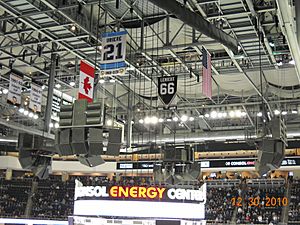
| No. | Player | Position | Career | Date Of Retirement |
|---|---|---|---|---|
| 21 | Michel Briere | C | 1969–1970 | January 5, 2001 |
| 66 | Mario Lemieux | C | 1984–1997 2000–2006 |
November 19, 1997 |
| 68 | Jaromir Jagr | RW | 1990–2001 | February 18, 2024 |
Notes
- Briere's number was taken out of use after his death in 1971. It was officially retired on January 5, 2001.
- Lemieux's number was used again when he returned to play in 2000. It was retired again on October 5, 2006.
- The NHL retired Wayne Gretzky's No. 99 for all teams in 2000.
Hockey Hall of Fame Members
The Pittsburgh Penguins have many people connected to them in the Hockey Hall of Fame. This includes 15 former players and five people who helped build the sport, like coaches and general managers.
Players
- Tom Barrasso
- Andy Bathgate
- Leo Boivin
- Paul Coffey
- Ron Francis
- Tim Horton
- Marian Hossa
- Jarome Iginla
- Mario Lemieux
- Joe Mullen
- Larry Murphy
- Mark Recchi
- Luc Robitaille
- Bryan Trottier
- Sergei Zubov
Builders
- Scotty Bowman
- Herb Brooks
- Bob Johnson
- Craig Patrick
- Jim Rutherford
Team Captains
Here are all the players who have been team captain for the Penguins:
- Ab McDonald, 1967–1968
- Earl Ingarfield, 1968–1969
- Ron Schock, 1973–1977
- Jean Pronovost, 1977–1978
- Orest Kindrachuk, 1978–1981
- Randy Carlyle, 1981–1984
- Mike Bullard, 1984–1986
- Terry Ruskowski, 1986–1987
- Dan Frawley, 1987
- Mario Lemieux, 1987–1994, 1995–1997, 2001–2006
- Ron Francis, 1995, 1997–1998
- Jaromir Jagr, 1998–2001
- Sidney Crosby, 2007–present
Team Records
Top Scorers

These are the top ten players with the most points in Penguins history. The numbers are updated after each NHL regular season.
- * – current Penguins player
Note: Pos = Position; GP = Games played; G = Goals; A = Assists; Pts = Points; P/G = Points per game
|
|
|
Top Goaltenders
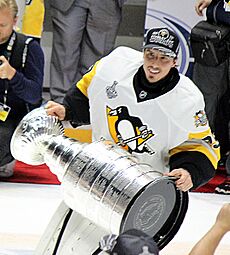
These are the top ten goaltenders in Penguins history by wins. The numbers are updated after each NHL regular season.
- * – current Penguins player
Note: GP = Games played; W = Wins; L = Losses; T = Ties; OT = Overtime losses; GA = Goal against; GAA = Goals against average; SA = Shots against; SV% = Save percentage; SO = Shutouts
| Player | GP | W | L | T | OT | GA | GAA | SA | SV% | SO |
|---|---|---|---|---|---|---|---|---|---|---|
| Marc-Andre Fleury | 691 | 375 | 216 | 2 | 66 | 1,713 | 2.58 | 19,487 | .912 | 44 |
| Tom Barrasso | 460 | 226 | 153 | 53 | — | 1,409 | 3.27 | 13,479 | .895 | 22 |
| Tristan Jarry* | 293 | 152 | 97 | — | 31 | 755 | 2.75 | 8,324 | .909 | 21 |
| Matt Murray | 199 | 117 | 53 | — | 19 | 505 | 2.67 | 5,877 | .914 | 11 |
| Ken Wregget | 212 | 104 | 67 | 21 | — | 644 | 3.29 | 6,285 | .898 | 6 |
| Denis Herron | 290 | 88 | 133 | 44 | — | 1,040 | 3.88 | 9,108 | .886 | 6 |
| Jean-Sebastien Aubin | 168 | 63 | 72 | 11 | — | 432 | 2.92 | 4,369 | .901 | 6 |
| Casey DeSmith | 134 | 58 | 44 | — | 15 | 340 | 2.81 | 3,870 | .912 | 9 |
| Les Binkley | 196 | 58 | 94 | 34 | — | 574 | 3.12 | 5,612 | .898 | 11 |
| Gregory Millen | 135 | 57 | 56 | 18 | — | 501 | 3.84 | 3,987 | .874 | 4 |
Team Rivalries
Philadelphia Flyers
The rivalry between the Philadelphia Flyers and Pittsburgh Penguins is considered one of the best in the NHL. It started in 1967 when both teams joined the league. The rivalry is strong because both teams are in Pennsylvania and play in the same division. The Flyers have a better overall record against the Penguins. However, the Penguins eliminated the Flyers from the playoffs in 2008 and 2009. The Flyers then eliminated the Penguins in 2012, making the rivalry even more intense.
The teams have met seven times in the playoffs. The Flyers won four series (1989, 1997, 2000, and 2012). The Penguins won three series (2008, 2009, and 2018).
Washington Capitals
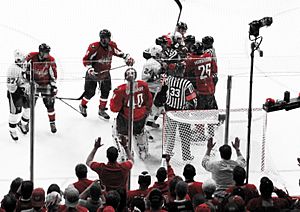
The Penguins and Washington Capitals have faced each other 11 times in the playoffs. The Penguins have won nine of these matchups. Their two series losses were in 1994 and 2018. The Penguins defeated the Capitals on their way to all five of their Stanley Cup victories. They have met in a decisive Game 7 in the 1992, 1995, 2009, and 2017 playoffs. The NHL's fourth Winter Classic, played on January 1, 2011, at Heinz Field in Pittsburgh, featured this rivalry. The Capitals won that game 3–1. The rivalry also extends to their minor league teams, the Wilkes-Barre/Scranton Penguins and the Hershey Bears.
Media Coverage
Radio Broadcasts
The Penguins' radio home is WXDX-FM. The Pittsburgh Penguins Radio Network includes 34 stations across four states: Pennsylvania, West Virginia, Ohio, and Maryland.
Broadcasters
Local TV station WTAE-TV broadcast Penguins games in their first season, with Sports Director Ed Conway doing the play-by-play. Joe Tucker took over in 1969. In 1970, Bill Hamilton became the play-by-play announcer, and John MacDonald joined as the first color commentator.
Mike Lange joined the Penguins' radio broadcast team in 1974. He became the TV play-by-play announcer in 1979. He worked with Terry Schiffauer and then Paul Steigerwald for many years. After Steigerwald left in 1999, Mike Lange worked with Peter Taglianetti and then Eddie Olczyk. In 2003, Olczyk left to become the Penguins' head coach. Bob Errey then became the color commentator.
In 2005, Mike Lange moved back to radio, and Paul Steigerwald returned as the TV play-by-play announcer until 2017. Steve Mears was hired as the new TV play-by-play announcer in 2017. Lange retired in 2021, and Josh Getzoff replaced him on radio. Phil Bourque is the radio color commentator. Before the 2023–24 season, Getzoff moved to TV, and Mears moved to radio. The Penguins now use a rotation of analysts for TV, including former players Colby Armstrong, Mike Rupp, and Phil Bourque. In 2024, Joe Brand replaced Steve Mears on the radio.
Every Penguins game is shown on the SportsNet Pittsburgh network. This network is available in many areas. The Penguins also get national TV coverage on American networks like ESPN, ESPN+, ABC, and TNT. In Canada, games are shown on Sportsnet and CBC.
In-Game Announcers
Ryan Mill has been the Penguins' public address announcer since 2009. Jeff Jimerson has been the team's official anthem singer since 1991.
See also
 In Spanish: Pittsburgh Penguins para niños
In Spanish: Pittsburgh Penguins para niños


